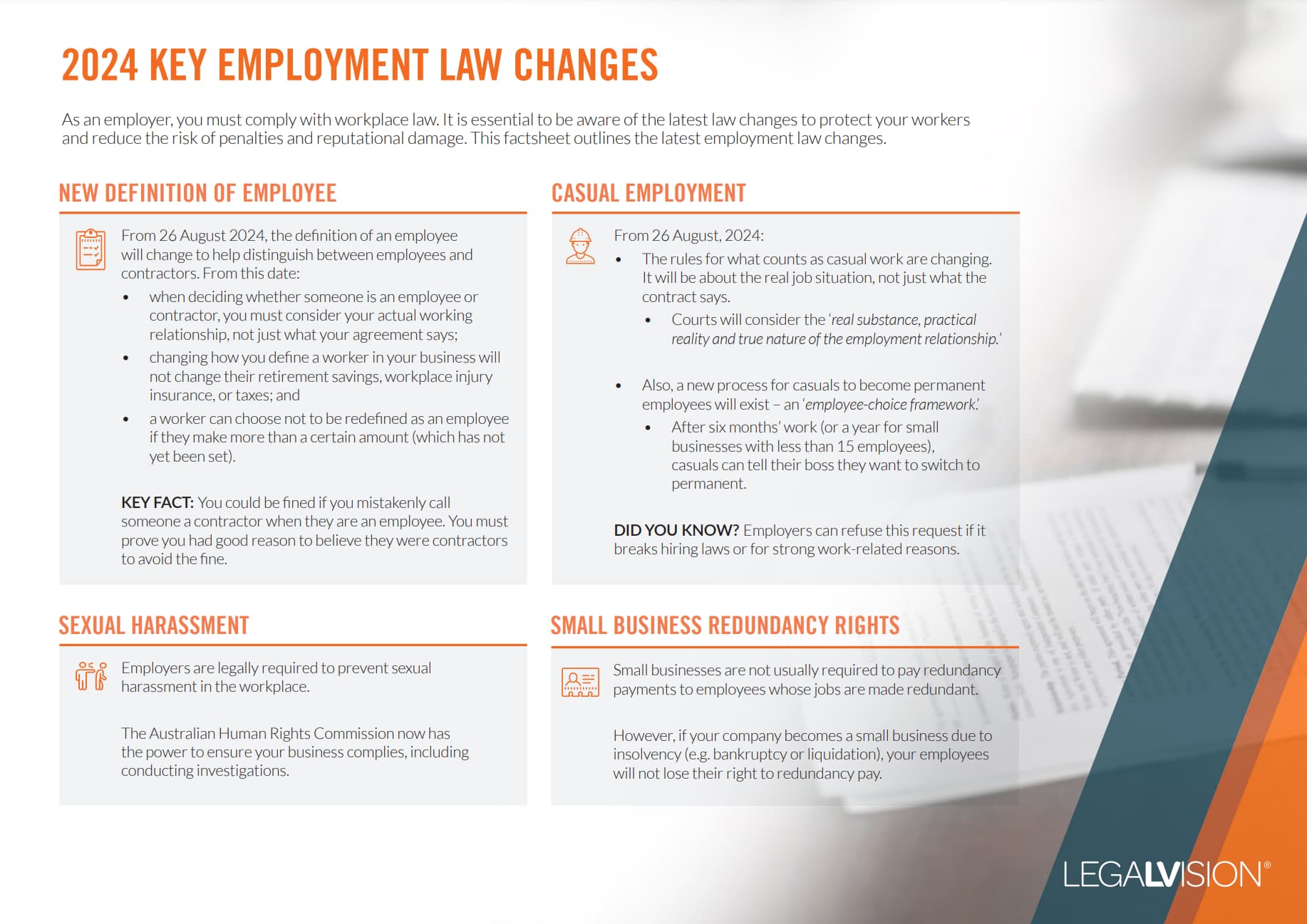As an employer, you may consider including restraint clauses in your employment contracts to protect your business. However, these clauses can be tough to navigate and understand. This article will unpack four key things to know about restraint of trade clauses.

As an employer, it is essential to understand what employment laws have changed and their implications for your business — particularly the changes to the Fair Work Act 2009 through the new Closing the Loopholes legislation.
What is a Restraint of Trade Clause?
A restraint of trade clause typically applies when an employee leaves your business. These clauses attempt to restrain employees’ activities after leaving. There are two different types of restraint of trade clauses, being:
- non-competition clauses, which restrict an employee from working for a competitor once their employment ends with you; and
- non-solicitation clauses, which restrict an employee from soliciting or poaching any of your business’ clients or personnel, once their employment ends with you.
Ultimately, these clauses attempt to protect your business by preventing any risks that your ex-employee might attempt to bring to your company.
When Are These Clauses Enforceable?
Courts are reluctant to enforce restraint clauses due to matters of public policy. For example, it is against public policy to stop people from working. As such a restraint of trade clause can only be enforced so far as it is reasonably necessary to protect legitimate business interests.
This will depend on your individual circumstances, including the:
- restraint clause itself;
- type of business; and
- seniority of the employee.
What Is Considered ‘Reasonable’ to the Court?
What makes a clause ‘reasonable’ to the Court will depend on each case.
However, these clauses need to protect an employer’s legitimate interest, and the scope of the restraint must be no bigger than is reasonably necessary to protect that legitimate interest.
A couple of factors to keep in mind when drafting your restraint of trade clauses include whether the:
- period of restraint is longer than what is necessary to protect your business;
- geographical limit of the clause is wider than necessary to protect your business interests; and
- clauses prevent the employee from engaging in activities beyond what is necessary to protect your business.
If any of the above factors apply, the court may not consider your restraint of clauses to be ‘reasonable’.
For example, a restraint clause is more likely enforceable against a senior-level employee with access to confidential information that may damage your business if leaked.
In comparison, a restraint clause against a low-level employee who may have limited or no access to your business’ confidential information is not likely to be considered reasonably necessary. Therefore, it may be considered unenforceable.
To protect yourself, you may choose to draft your contract with cascading clauses. A cascading clause is essentially independent and separate paragraphs in a clause that can be struck out by a court if they are unreasonable, leaving the remaining alternatives to be considered.
- 12 months;
- 6 months; or
- 3 months.
What Happens if an Employee Breaches the Restraint of Trade Clause?
If an employee breaches a restraint of trade clause, you will need to consider whether you would like to take any action to enforce the clause. It is important to consider what steps you can take before commencing any legal proceedings, as enforcing a restraint clause can be:
- stressful;
- time-consuming; and
- costly.
One of the first steps you can take if you think an employee is breaching a restraint of trade clause is to send a letter reminding them of their post-employment obligations and requiring them to stop breaching their obligations. If this does not stop the employee, you may consider taking urgent legal action, such as seeking an injunction.
It is important to make sure your clauses protect more than just ensuring you have no competition. The Court will evaluate the type of employee you are trying to restrain and the kind of knowledge and expertise they would take with them.
For example, in a recent high-profile case, the court enforced a restraint of trade clause because the employee was in a senior position and had access to confidential information. Additionally, the business was small and would be affected by the employee working for a competitor and taking their clients.
[publication-promo]
Key Takeaways
Restraint of trade clauses are important when trying to protect your business from losing employees, clients, or information. However, drafting them can be tricky as you need to consider reasonableness, enforceability and potential remedies. If you believe that your ex-employee has breached a restraint of trade clause, you should consider how to respond, including by taking legal action.
If you need help drafting your employment agreement, our experienced employment lawyers can assist as part of our LegalVision membership. For a low monthly fee, you will have unlimited access to lawyers to answer your questions and draft and review your documents. Call us today on 1300 544 755 or visit our membership page.
We appreciate your feedback – your submission has been successfully received.











